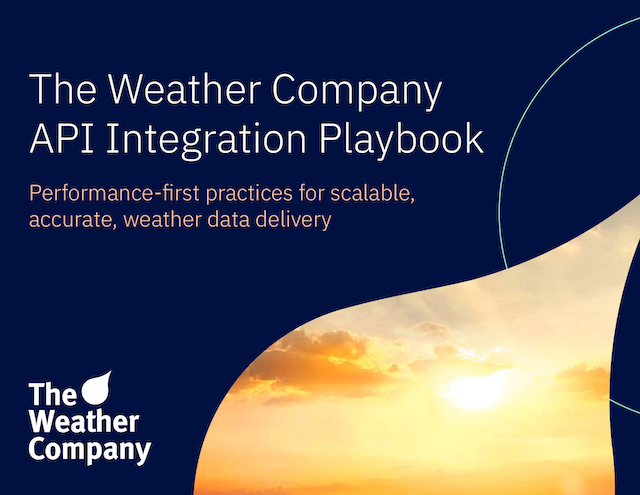Weather intelligence for the future: Crafting a strategic enterprise approach to changing environmental conditions
Continue readingKey takeaways
- Scalable API architecture relies on standardized queries, smart caching, and user-driven data updates.
- The Weather Company APIs include built-in caching headers to optimize speed and reduce server load.
- API efficiency improves when data is requested based on user interaction rather than prefetching.
- Mobile applications benefit from shared data layers that limit duplicate API calls across experiences.
- Structured geocode formatting and reduced parameter variability increase cache hit rates at scale.
Note: This blog post is a general, illustrative guide and not a comprehensive implementation plan. Weather APIs may vary depending on use case, geography, or product configuration. For specific recommendations, The Weather Company is available to assist.
Modern applications must be fast, responsive, and cost-effective – especially as user demand grows. That challenge becomes more complex when real-time data like weather is involved. Developers need smart tools and strategies to maintain performance at scale. The Weather Company offers solutions built for growth and helping teams create a scalable API architecture to meets evolving demands.
Caching turns weather data into high-speed performance
Heavy traffic can slow down an application, especially if it relies on repeated API requests. The Weather Company addresses this with built-in caching mechanisms in every API. Each response includes headers with a Cache-Control → max-age=x seconds directive, clearly stating how long the data remains valid.
Take the Current Conditions API. Its max-age might be set to 600 seconds. That means the app can reuse the same data for up to 10 minutes without making another request. When your application hits a surge in users – say during a major storm – your cache absorbs much of that load, improving response time and lowering costs.
User-driven updates can improve scalable API architecture
Some applications try to predict what users need before they ask. But that often leads to wasted API calls. Responding only when users need new data can be a better method.
Consider lazy loading. If only half of a screen is visible, only that portion should request data. As the user scrolls, the rest can load incrementally. Analytics can also guide optimization. Watching how users interact with your app can help you decide what to prioritize in real time.
Weather data can also be updated for mobile use cases based on specific user behaviors – like a location change, a screen refresh, or an app wake state. Implementing event-driven logic keeps data timely and can minimize unnecessary traffic. The goal is to balance responsiveness with restraint, enhancing API efficiency without taxing backend infrastructure.
This approach can be particularly useful for developers building an API for mobile app environments. A mobile device can store one API response and share it across different parts of the app. A single call powers multiple user experiences, and that’s a huge step forward in performance.
Structured queries can reduce overhead without cutting features
Another tactic for a scalable API architecture is structuring queries in a consistent, efficient way. Even small changes in request formatting can lower cache effectiveness. That’s why The Weather Company recommends standardizing things like case sensitivity and precision.
For instance, when using geographic coordinates, rounding to two decimal places keeps requests uniform, which raises cache hit rates. In addition, The Weather Company actively rounds geographic coordinate API queries to two decimal places (~every 1.1 km) for our own caching purposes. This means additional precision beyond two decimal places is wasted efficiency and does not result in a higher resolution response.
Here’s a quick example:
A request to /v3/wx/observations/current? may not match a cached result for /v3/wx/observations/current?, even though the data payload would be identical. By reducing variability, developers improve cache utilization and speed up responses – especially at scale.
Less variation can mean more efficient server responses and better performance, even in large-scale deployments. That’s critical when your app may serve thousands, even millions, of users at once.
Scale in action
The Weather Company delivers scalable APIs proven in enterprise environments. Our APIs serve some of the world’s most widely used platforms, including weather.com and mobile apps that reach millions of devices per second. During critical events like hurricanes or major snowstorms, APIs automatically scale in real time to meet demand without breaking service. As the world’s most accurate forecaster,1 The Weather Company delivers the precision and reliability needed during high-impact events like hurricanes and snowstorms.
Scalability also extends into specialized domains. In aviation, The Weather Company provides live weather data for visualization tools that help guide decisions in the air and on the ground. These applications demand reliability, precision, and uninterrupted access, especially in fast-changing atmospheric conditions.
Other sectors rely on this same stability. In agriculture, for instance, real-time weather data feeds into irrigation planning and crop modeling. Even minor delays or inaccuracies can affect yields, making uptime and freshness of data essential.

The Weather Company API Integration Playbook
Get your copyBuilt for developers and decision-makers alike
The Weather Company supports a wide range of technical roles, offering tailored resources that help teams succeed at every stage of API implementation. Backend developers gain access to deep integration guides and robust error handling. Mobile developers benefit from caching documentation and versioning best practices. Meanwhile, product managers and business analysts can use usage metrics and competitive insights to align technical decisions with strategic goals.
For each persona, you’ll find a tailored mix of tools, from detailed documentation and pre-built connectors to API explorers. By understanding the distinct needs of each team member, we help empower developers to build scalable platforms that meet real-world demands.
Next steps for scalable design
Scalability depends on thoughtful choices that balance performance, cost, and user experience – not just backend capacity. We invite you to take the next step with The Weather Company APIs by reviewing our developer documentation or requesting a free API trial. With The Weather Company, developers can build resilient systems that can grow effortlessly alongside their audience. Whether you’re building for smartphones, the web, or the skies above, smart API strategy is the foundation of a seamless experience.
Let's talk
Contact our experts today to discover how Weather Data APIs can empower your decision-making and strengthen your business resilience. Let us help you transform weather data into a strategic asset.
Contact us1 ForecastWatch, Global and Regional Weather Forecast Accuracy Overview, 2021-2024, commissioned by The Weather Company

